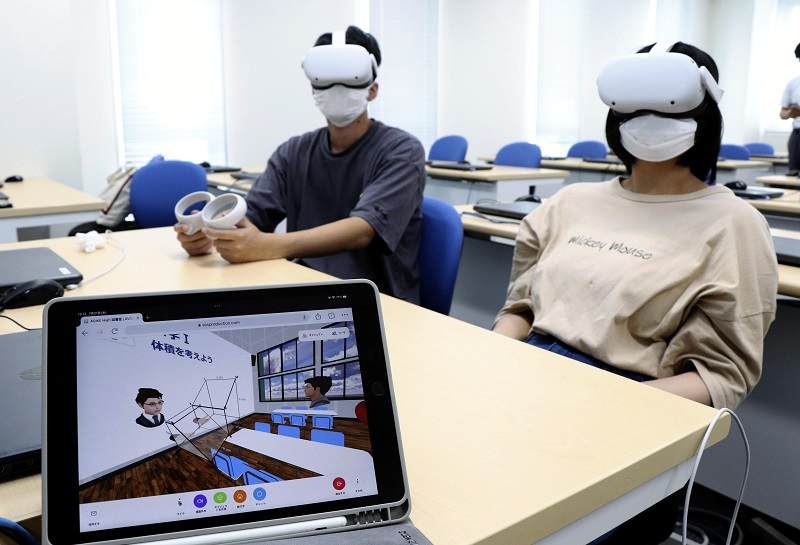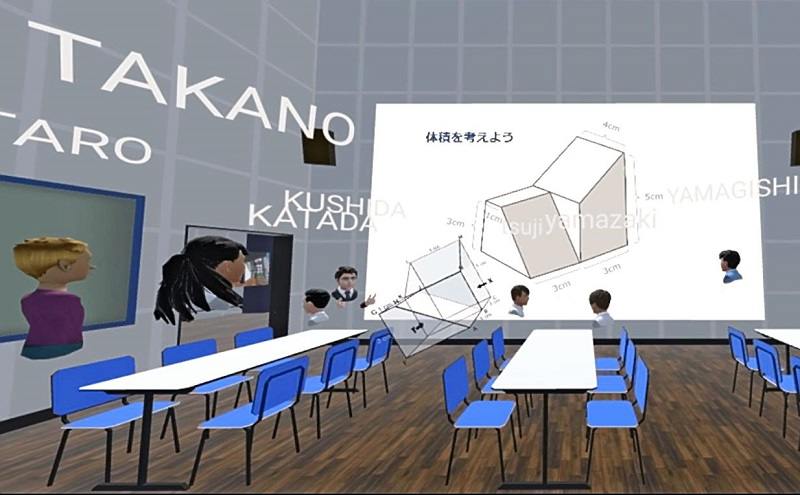Distance-learning high school holds classes in the metaverse

Aoike High School students are seen wearing virtual reality goggles during a class held in the metaverse on July 21.
20:00 JST, August 16, 2022
TOYAMA — A distance-learning high school based in Obama, Fukui Prefecture, has started holding classes in the metaverse, a virtual environment where users in different locations can interact with each other.
Since spring, Aoike High School students have been able to communicate with their teachers and classmates in the form of avatars, digital depictions of users that appear as bodiless heads in the metaverse platform utilized by the school.
On July 21, first-year students were taking a math lesson in a virtual classroom. The users’ names were displayed above the head of each avatar.
“This solid is in a shape like this. Let’s confirm it with a three-dimensional model,” the teacher said, after which the students manipulated virtual models in the metaverse to understand the shape of the object.
Back in the real world, the teacher and some students were wearing virtual reality googles, controlling their respective avatars while seated in a classroom at Aoike High School’s Toyama campus.
According to officials of the school, about 30 students attend classes in the metaverse up to three times a week, studying subjects including mathematics and biology.
“In the metaverse, you don’t feel far from the other participants,” said first-year student Ruiji Takashima, 18. “It was easier to visualize and understand three-dimensional shapes than it would’ve been in a face-to-face class.”

Avatars of students and a teacher are seen in a class held in the metaverse.
The school used to have a catchment area that only covered the six prefectures in the Hokuriku region, but since April it has accepted students from across Japan, which prompted the move into the metaverse.
Although one of the goals is to make classes available throughout Japan, another is to help students attend face-to-face classes without feeling pressure. About half of the school’s students have had problems with school attendance in the past. Aoike High School hopes that holding classes in the metaverse improves the school experience for such students.
The design of each user’s avatar is based on a headshot taken at the school, but it’s possible for the students to modify their avatars with different hairstyle options and the possibility of adding eyeglasses, among other things.
Naoki Yamagishi of Aoike Gakuen, which operates the school, said students can also interact with students in the metaverse outside of class hours. “Even students who can’t go to school are able to have conversations with classmates and enjoy an experience similar to that of attending a conventional school,” Yamagishi said.
Takanobu Fuji, chief analyst of the Hokuriku Economic Research Institute, thinks metaverse schooling will change the way students communicate in the future.
“Videoconference tools have proliferated amid the coronavirus pandemic, and many schools and offices have shifted online. But it’s easier to have casual chats in the metaverse than on videoconference calls,” Fuji said.
Metaverse platforms offer virtual environments in which users can socialize, study, work, and perhaps even shop in the future, by controlling their respective avatars. Concerts, museums and tourist spots are among some of the applications that have taken advantage of the new technology.




